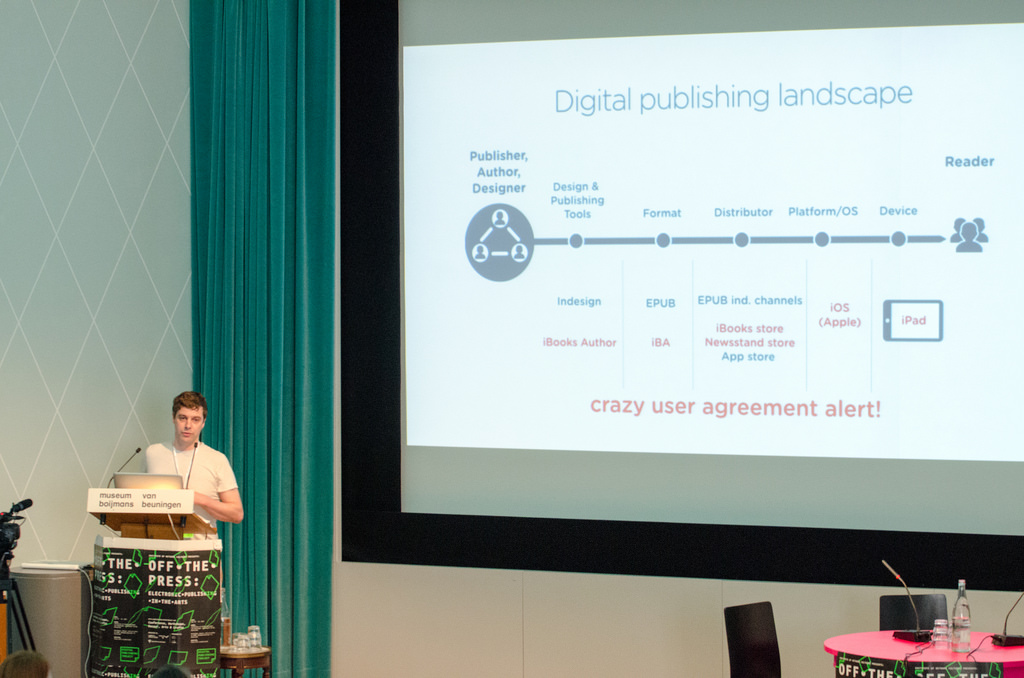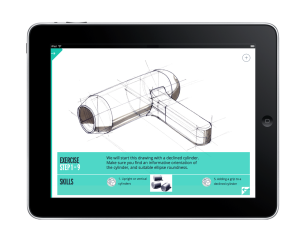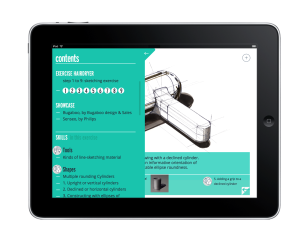De Jong is a visual designer for design agency Essense and a member of BIS Publishers, both located in Amsterdam. He attended the conference “Off the Press: Electronic Publishing in the Arts” as a representative of the latter and shared the production process of two of their recent e-publications.

The first case study he presented was the translation of the best seller book titled “Sketching: The basics” by Roselien Steur an Koos Eissen into an e-publication (app) that design students and creative professionals would find easier to learn from. The desired output was for the e-publication to be highly interactive and visual while allowing the readers to choose between different narratives (linear reading versus fragmented, personalized reading). The idea was to focus on the book’s purpose – to teach “the basics” of sketching. With the app (soon to be launched), design students can choose if they want a step-by-step teaching process or dive directly into specific skills. They can also choose to read on theory or practice bits, or jump to industry experts’ highlights.
This is how the demo of the app looks like:


The other case study was translating the book “Think like a lawyer, don’t act like one” by Aernoud Bourdrez into an electronic publication (EPUB3). In this case, they opted for a neat, flat design in order to stay as close as possible to the printed version. In either cases, BIS Publishers followed the same workflow, which De Jong shared with the audience.
He first stressed out that one of the most important steps in the workflow is knowing what you’re looking for in the upcoming product. This means researching your target audience: who are they? What devices do they use? How do they engage with reading and exploring? What is the best format for them? Are they permanently online? etc. These insights further dictate what type of content is more suitable (flat text or rich media? Linear or fragmented narratives?).
Then, the authors, designers and publishers (more often than not, one can play all three roles) choose the design and publishing tools to work with. They can opt for either open tools (a wide range of developer tools, Baker Framework, Sourcefabric) or proprietary tools (InDesign, iBooks Author, LayerGloss, PressMatrix).
Second, a decision on format is required: would ePub, iBook, Mobipocket or a stand-alone app better suit the purpose? De Jong argues in favor of open, flexible and sustainable formats; in his experience CSS, EPUB, Hybrid and the likes work best.
The third step is picking a distributor: iTunes, App Store, Newsstand, Google Play, Amazon App Market or indirect distribution. When choosing a distributor, De Jong warns about the terms and conditions that apply with proprietary distributors like Google, Amazon or iTunes, as they often require the right to exclusive distribution. Once the distributor(s) is chosen, publishers opt for the platform, such as IOS, Android or Kindle.
Finally, the product is made available on a device: iPad, Android Tablet or Kindle.
At BIS Publishers, De Jong works mostly with rich content (interactive, audio, video, fragmented narratives) and thus prefers tablets and apps. His checklist contains full color screen, high resolution, sound, and internet connection. There are further technical aspects to be considered on the long run, like the fact that updating an app is easier and cheaper than buying a new e-reader. Different desired outcomes dictate the use of different tools and platforms.
You can find a PDF of his original presentation here: Presentation Arjen de Jong


